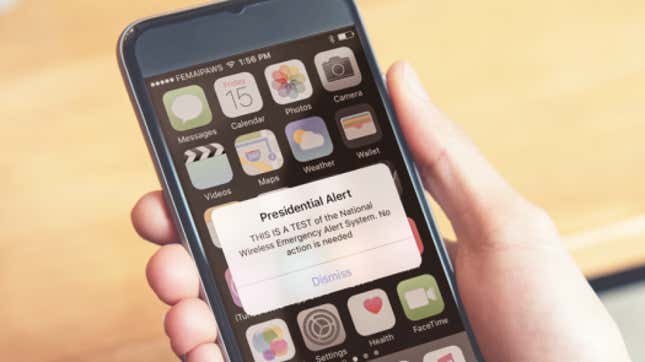If you’re in the U.S. and you weren’t on a long call or out of cell range, you probably noticed your phone just go off.
It probably made a noise like a siren; it may have vibrated all over your desk; it may also have embarrassed you in a meeting or a silent subway carriage. Around 225 million cell phone users in the U.S. just got a message from the White House, and it said something like this: “THIS IS A TEST of the National Wireless Emergency Alert System. No action is needed.”

Though it wasn’t the U.S. government’s first test of the Emergency Alert System, it was the first to use texting. The system has technically been in place since April 2012, but the Federal Emergency Management Agency (FEMA) is only now taking it for a test drive. (It’s been used since then by local governments to warn people about weather events like flash flooding or for AMBER alerts about missing children.)
Unlike other emergency alerts, which you can turn off in your phone’s settings, there’s no getting out of this one. The 2006 law that established the wireless alert system permits carriers, and their users, to opt out of emergency alerts about heavy storms or missing children—but you’re obliged to get the ones that come direct from the federal government.
Despite the name, this afternoon’s alert didn’t come from the very active thumbs of Donald Trump, however, but rather from a federal government agency under his direction. And though it’s tempting to make jokes about what happens if Trump were to link the system up to his Twitter account, FEMA has all but promised that won’t happen. Instead, “Presidential Alerts” will only be triggered in the event of an actual national emergency, whether that’s a declaration of war, coordinated terrorist attacks, or some other security breach. FEMA claims neither Trump nor any future US president will be able to use the WEA system for any other purpose, Variety reports.
Instead, they’ll be at the discretion of the federal agency perhaps best described as the US “secret doomsday planner.” FEMA tends to keep its work under lock and key—but the agency is basically responsible for overseeing what Wired calls “the so-called “continuity of government” efforts that would ensure the evacuation of key officials to mountain bunkers and airborne command posts after a catastrophe.” In other words, wholesale disaster.
So while you may not be able to opt out of these messages, if you get one for real (hopefully for real, at least), you’ll likely have far more important things to worry about. Still, a text is a relatively manageable way to learn about the end of the world—at least compared to the pink weather balloons or hijacked Muzak networks that once seemed like good options for a doomsday alert.
